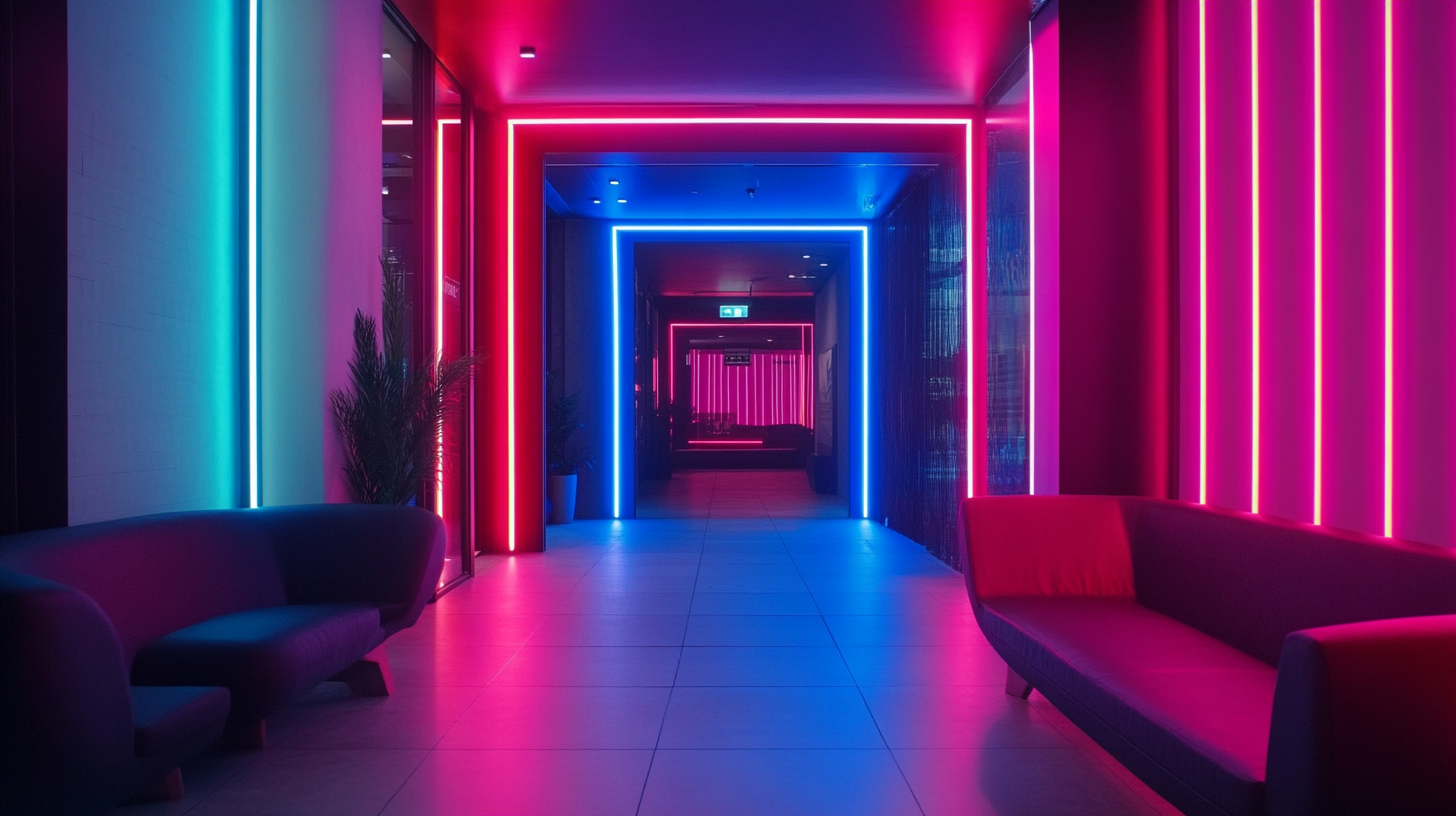Exploring the Key Specifications of Smart LED Lightstrips: A Comprehensive Installation Guide for Global Buyers
Smart LED Lightstrips are gaining popularity these days, thanks to the innovative smart home technologies and the need for customizable lighting. The global smart lighting market is expected to be worth $75.9 billion by 2025, growing at a CAGR of around 23%. This growth is an indication of how fast consumers realize they can make their spaces energy-efficient without compromising the seamlessness in smart devices fitting into daily living spaces. Smart LED Lightstrips have become a whole new range of choices for the home-from-renter, enhancing any ambiance by operating through remote control and automation.
While globalizing consumers are progressively making their spaces cozier, it is essential that they learn what special features and installation processes these lights offer. Like other smart LED Lightstrips, which include such features as color-changing, programmable and energy-saving technologies, this variety is applicable in home design to event lighting. Installation and choice of Smart LED Lightstrips can easily be made by consumers with adequate guidance and knowledge, so they can enjoy their home spaces with simplicity. It covers everything that the buyer would want so that he or she would be fully equipped with all the information that could help him or her make an informed decision and enjoy the cost of buying lights.

Understanding the Basics: What Are Smart LED Lightstrips?
Smart LED light strips have become all the rage with the ability to alter spaces with an adaptable lighting concept. Designed for flexibility and easy installation, these light strips do not serve just an aesthetic purpose; they actually bring several benefits to the party. Such features-as much adjustable color, dimming, and interaction with smart home systems-both casual decorators and tech lovers will find hard to resist. Smart LED light strips consist of small LED lights arranged on a flexible strip in their simplest description. This means there are multiple applications, be it outlining architectural features, lighting up home theaters, or creating ambiance for outdoor spaces. The app or voice assistant controls allow the user to adjust the lighting from anywhere simply by telling the system what to do, customizing the ambiance for any occasion. Plus, as energy efficiency is now one of the hallmarks of modern electronics, smart LED light strips draw comparatively very tiny power as against their predecessors. Thus, their utility in saving on electricity bills, discomfort to Earth, and carbon footprints And, as time goes by, advanced scheduling and synchronization features are likely to come about in which lighting systems sync with your melody, respond to changes in the ecosystem, and provide stunning flavors of life and decor-a combination of all this has proven to be much sought after by consumers across the world.

Key Features to Look For When Choosing Smart LED Lightstrips
But to make an informed buying decision, understanding the key features of Smart LED Lightstrips is very important. Chief among these are brightness and color options; many smart lightstrips boast of adjustable brightness levels and all the colors one could think of, changeable via a smartphone app. One would understand how to create an evening's coziness with proper lights or get a full lively ambiance for all party activities.
Another thing, one has to put into consideration, is the connectivity options. The last in the line of evidence that a smart LED lightstrip should include are the hubs and ecosystems it is compatible with: Google Assistant, Amazon Alexa, and Apple HomeKit, to mention just a few. It is integrated well into everything else that you are having around your smart devices along with more natural user control through voice command or automatically created routines. Wi-Fi or even Bluetooth compatibility is going to give an alternative options in controlling the light setup from home or away.
Durability and adhesive quality also rank among the critical considerations for evaluating features. An ideal couple of lightstrips should rather be eternal; durable, if not eternal at least should be made from good quality materials capable of withstanding the wear and tear. An adhesive backing must be designed in such a way that it is easily applied and removed, particularly if you will be relocating the lightstrips frequently. By concentrating on these specific specifications, you can select smart LED lightstrips that not only beautify your interiors but also help in practical usage day in and day out.

Step-by-Step Installation Process for Smart LED Lightstrips
Installing smart LED light strips can be a fantastic way to enhance any living space: aesthetic and functional. This will be a step-by-step walkthrough reassuring you that all these things will be installed for you to experience these bright visuals and functionalities that these lightstrips offer. Gather your components in advance: the lightstrip, power adapter, remote control or smartphone app, and any tool needed for setup.
Begin by determining where you want the installation to take place. Clean the area and ensure there is no dust or grease on it as it is meant to hold well. If it's an adhesive type, peel back the protective layer carefully as you press the lightstrip firmly onto your area. These strips should ideally be placed around edges, edges of shelves, on walls, or hidden behind furniture, so their effects are completely removed. Make sure that corner areas are handled with care; cut in the prescribed points to allow junctions through corners without compromising function.
The next thing you do is place your light strip and plug it into the power and set up any necessary connection. If your system comes with smart features, download the application specific for this product and follow the pairing instructions given by the manufacturer. It usually requires connecting your light strip to Wi-Fi so that you can control it from your smartphone, customizing colors, brightness, and preset patterns. Spend some time with different settings, as there is likely a combination that works best for your moods-whether to relax, party, or work. Enjoy your newly brightened space!

Compatibility Concerns: Ensuring Your Lightstrips Work with Smart Home Systems
Compatibility with existing smart home systems is critically important for customers considering the setup of smart LED lightstrips. Many consumers purchasing such innovative lighting solutions think it will easily mesh with their home automation systems. The reality, however, can become much more complicated. Depending on the brands and models of smart LED lightstrips, communication may not always be straightforward between all smart home platforms, thereby causing frustration and delaying use.
For smooth integration, it is paramount to compare the specs and compatibility of lightstrips with the smart home ecosystem you have in place. Popular systems such as Amazon Alexa, Google Assistant, or Apple HomeKit each has specific requirements and protocols. Per example, some lightstrips may need a dedicated hub to connect to Wi-Fi, while others can work straight over Bluetooth. A little research in this area or consulting manufacturer guidelines will serve you well and, hopefully, help you to avoid compatibility headaches later.
On top of that, check for firmware updates and app integrations that may be needed to get the best performance out of your smart LED light. Some of them have their own apps with additional features, but their synchronization with your main smart home management app may not always be reliable. Investigating whether the lighting system supports IFTTT or can be controlled through any API integrations can further augment functionality and user experience, making sure the new light strips integrate seamlessly into your smart home setup.
Tips for Customizing and Managing Your Smart LED Lightstrip Experience
When establishing good lighting in a living room, smart LED lightstrips provide a unique mix of customization and easy configuring. One of the main distinguishing features of these lightstrips is the availability of personal taste customization in these flexible color patterns according to your mood. Most of these smart LED lightstrips allow users to adjust colors, brightness, and effects by means of user-friendly mobile apps, thereby enabling one to apply the right ambiance for any particular occasion. Be it a party, a movie night, or some off time; having that ability is something that would really enhance one's experience.
More so, controlling your smart LED lightstrip is not just about choosing colors. Many systems feature compatible voice assistants for the ultimate convenience: hands-free control. Imagine asking your lights to dim or change color! You can also set them on schedules to turn on or off at certain times of the day or have them synced to music for a groovy light show. With this level of engagement, your atmosphere becomes all the more lively and lighting becomes more closely intertwined with your everyday serendipity.
Your experience with lightstrips can drastically change; therefore, it is encouraged that you engage in testing some other configurations or placements. Wrapping them around furniture, or tucking them under cabinets, can lead to stunning dramatic effects that highlight your décor. In addition, remember scenes or presets in your favorite app for quick and easy set-up of lighting to suit your needs. Smart LED lightstrips create infinite options for brightening your space and thereby are an exciting addition to any modern home.
